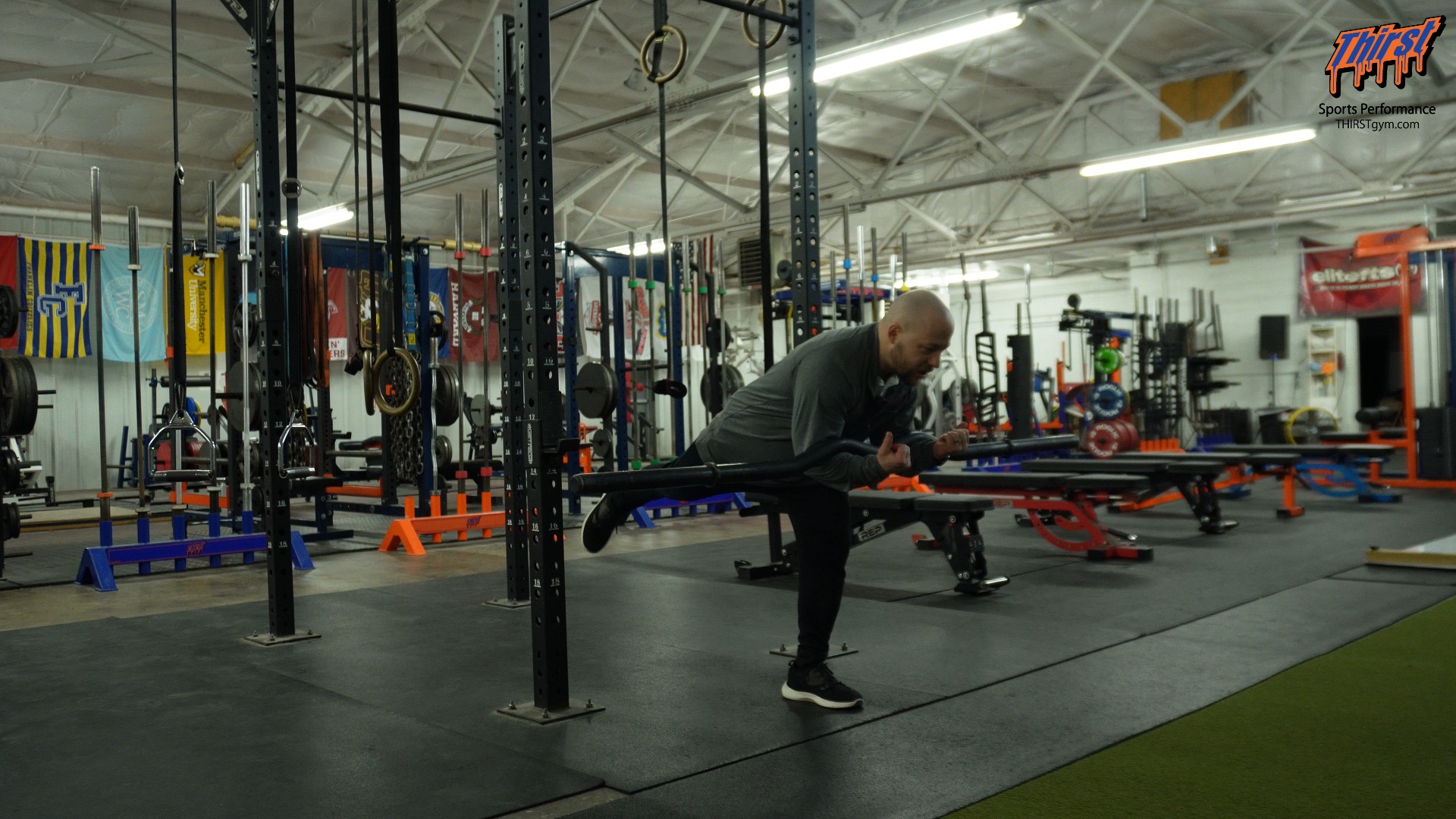Single Leg Barbell Zercher RDL: Advanced Posterior Chain Development
Looking to elevate your single-leg training? The Single Leg Barbell Zercher RDL combines stability, strength, and functional movement patterns for serious posterior chain development.
Watch the video below on how to maximize this exercise.
What Is the Single Leg Barbell Zercher RDL?
The Single Leg Barbell Zercher RDL (Romanian Deadlift) is an advanced unilateral hinge pattern exercise that combines the stability challenge of single-leg training with the unique anterior loading position of the Zercher hold. This exercise effectively targets the glutes, hamstrings, and hip stabilizers while engaging the core and upper back for total posterior chain development.
Equipment Needed
- Barbell (standard straight barbell or specialized options like a zigzag barbell)
- Squat rack with adjustable J-hooks
- Optional: Barbell pad for arm comfort
Muscles Worked
- Primary: Glutes, hamstrings
- Secondary: Erector spinae, core stabilizers
- Stability: Hip abductors/adductors
- Isometric: Upper back, biceps, forearms
Exercise Setup and Technique
Starting Position:
- Set the J-hooks at approximately waist height
- Position the barbell in the crooks of your elbows (Zercher position)
- Keep your palms facing toward your body
- Stand tall with a slight reach of the barbell away from your body
- Maintain an upright torso position
Execution:
- Walk out from the rack and establish a stable position
- Shift your weight to one leg (keeping a soft knee)
- Begin the movement by hinging at the hips, not the lower back
- As you hinge, reach the barbell slightly forward while extending the non-working leg behind you
- Maintain a neutral spine throughout the movement
- Lower until you feel a stretch in the hamstring of your working leg
- Drive through the heel of your working leg to return to the starting position
- Tap the non-working foot to the ground between reps for stability
- Complete all repetitions on one side before switching legs
Form Tips and Common Mistakes
Proper Form:
- Keep a soft bend in the supporting knee
- Maintain whole foot contact with the ground
- Move from the hips, not the lower back
- Let the non-working leg rise naturally as you hinge
- Keep the barbell position stable throughout the movement
Avoid These Mistakes:
- Rounding the lower back
- Leaning too far forward or backward
- Keeping the non-working leg down while hinging
- Holding the barbell too close to your body
- Rotating the hips (keep them square)
Why Choose the Zercher Position?
The Zercher position offers unique benefits for single-leg RDLs:
- Anterior Loading: Creates space for posterior movement and encourages proper hip hinging
- Stability Challenge: Removes hand support, increasing the balance demand
- Progressive Overload: Allows for heavier loading compared to dumbbell variations
- Movement Honesty: Makes it harder to cheat the movement pattern
- Athletic Carryover: Mimics positions and stability demands found in sports like wrestling
Programming Recommendations
As a Main Movement:
- Strength Focus: 2-4 sets of 6-8 reps per leg
- Hypertrophy: 2-3 sets of 8-10 reps per leg
- Rest Periods: 60-90 seconds between legs, 2-3 minutes between sets
Exercise Placement:
- Ideal as a main lower body exercise on hinge-focused training days
- Excellent alternative to conventional deadlifts or standard RDLs
- Can be programmed as the primary unilateral exercise in a lower body session
Load Management:
Keep repetitions under 10 per set to prevent upper back fatigue from limiting the exercise. The position naturally limits the amount of weight you can use, providing built-in safety while still allowing for significant loading of the posterior chain.
Progression Path
If you’re new to this exercise, consider this progression path:
- Two-leg RDL with dumbbell or kettlebell
- Single-leg RDL with hand support for balance
- Single-leg RDL with dumbbell or kettlebell in one hand
- Two-leg Zercher RDL
- Single-leg Zercher RDL with light weight
- Full Single-leg Barbell Zercher RDL
Benefits Beyond Strength
- Enhanced Hip Stability: Critical for athletic performance and injury prevention
- Core Development: The anterior load challenges anti-extension stability
- Upper Back Endurance: The isometric hold builds postural strength
- Improved Balance: Single-leg training transfers to many functional movements
- Asymmetry Correction: Helps identify and address side-to-side differences
Who Should Try This Exercise?
The Single Leg Barbell Zercher RDL is particularly beneficial for:
- Athletes in sports requiring hip power and stability (wrestling, football, etc.)
- Intermediate to advanced lifters looking for new posterior chain challenges
- Individuals with sufficient hip mobility and core stability
- Trainees wanting to address bilateral imbalances
This is not an entry-level exercise – ensure you’ve mastered basic hinge patterns before attempting this advanced variation.
Final Thoughts
The Single Leg Barbell Zercher RDL combines multiple training elements into one efficient exercise. By challenging stability, strength, and movement patterns simultaneously, it offers significant benefits for posterior chain development that go beyond what many traditional exercises can provide.
Add this exercise to your training program when you’re ready for an advanced challenge that will build functional strength, improve athletic performance, and develop impressive glute and hamstring development.








